Review: Beyonce and Jay-Z's video at the Louvre ★★★★☆
- Published

More than 8 million people visited the Louvre in 2017. The vast majority of them would have rubbed shoulders with the same famous artworks that appeared this week in The Carters' (that's Beyoncé and her husband Jay-Z) music video for the launch track from their new album, Everything is Love.
I doubt many gyrated in leggings and a bra in front of Jacques-Louis David's monumental canvas The Consecration of the Emperor Napoleon (1806-7) as Beyoncé does in the video, but I imagine people will now.
Blame Napoleon for encouraging such behaviour.
When he was presented with the canvas having insisted on several alterations, like reducing the size of Notre-Dame cathedral to make him look bigger, the delighted Emperor said: "This is not a painting; one walks in this picture."
The Carters get up to all sorts in this personalised take on Night at the Museum, the title of which made use of asterisks when it was uploaded to YouTube last weekend given its bad language.
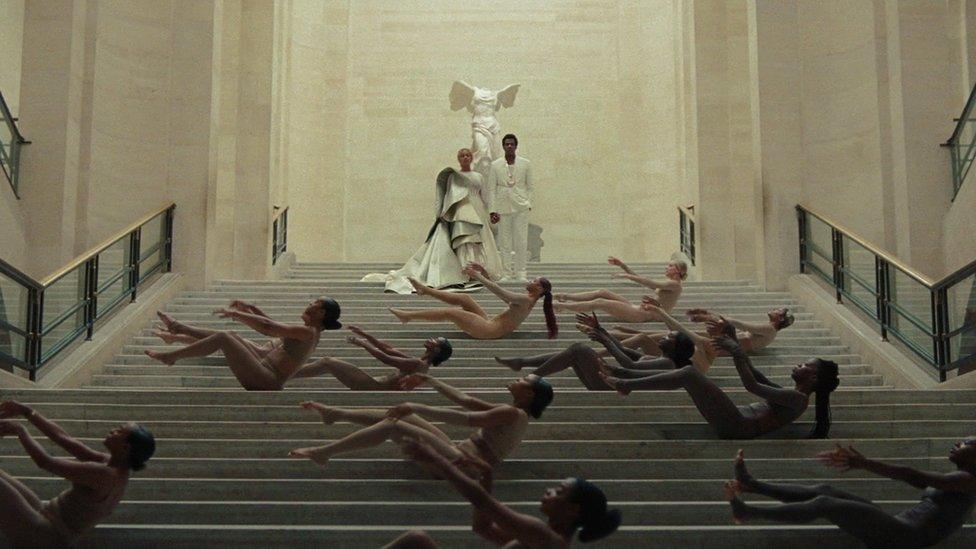
In one scene they appear dressed in white, like marble statues, standing regally at the top of the Winged Victory of Samothrace staircase as the magnificent winged goddess Nike rises from behind their heads while their loyal subjects lie down before them.
In another, they hang out with the ancient Great Sphinx of Tanis, which came from the Temple of Amun Tanis, once the pharaohs' seat of power in the dim and distant 21st and 22nd Dynasties. Jay-Z stands aside, while Beyoncé dances frenetically.
Like most museum visitors, they take regular breaks - chilling out on the Louvre's plush sofa-seats; Jay-Z man-spreading as Beyoncé uses his shoulder as a chair back. They appear to be having a great time.
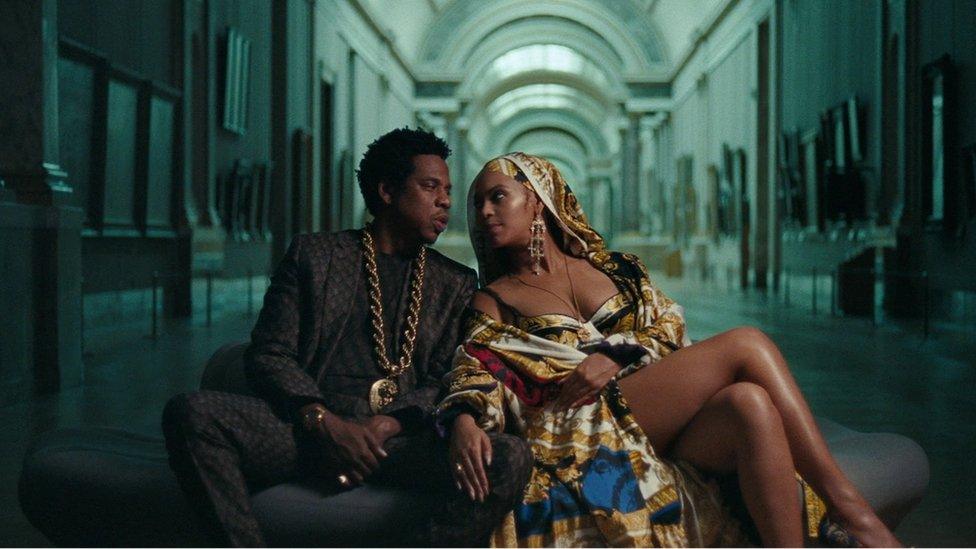
Although, the longer the video goes on the more you realise there is something slightly odd about their visit. I'm pretty sure that just about every single one of the Louvre's 8 million-plus visitors takes the opportunity to have a good look at the masterpieces on show.
The Carters do not. At least, not until the dying seconds of their six-minute promo, when they face each other before slowly turning towards Leonardo da Vinci's Mona Lisa.
This isn't an oversight; it is a point - maybe, the point - being made.

They are not in the Louvre to look reverentially at great works of European art; they are there to make their own great work of art. The museum and its contents are not the star of this show; they are there to play a part.
Pop's power-couple, along with director Ricky Saiz, have produced a series of vignettes, all of which play with the same dramatic device: inserting a contemporary black artistic voice into a white, Western, male-dominated, establishment narrative.
I don't know if they specifically chose The Consecration of the Emperor Napoleon to dance in front of because it was the colonising French general who repealed anti-slavery laws in 1802, but I imagine the fact hadn't escaped their notice.
There is no ambiguity with the elegantly-composed image they curate in front of David's painting Portrait of Madame Récamier (1800), which is heavily laden with symbolism.
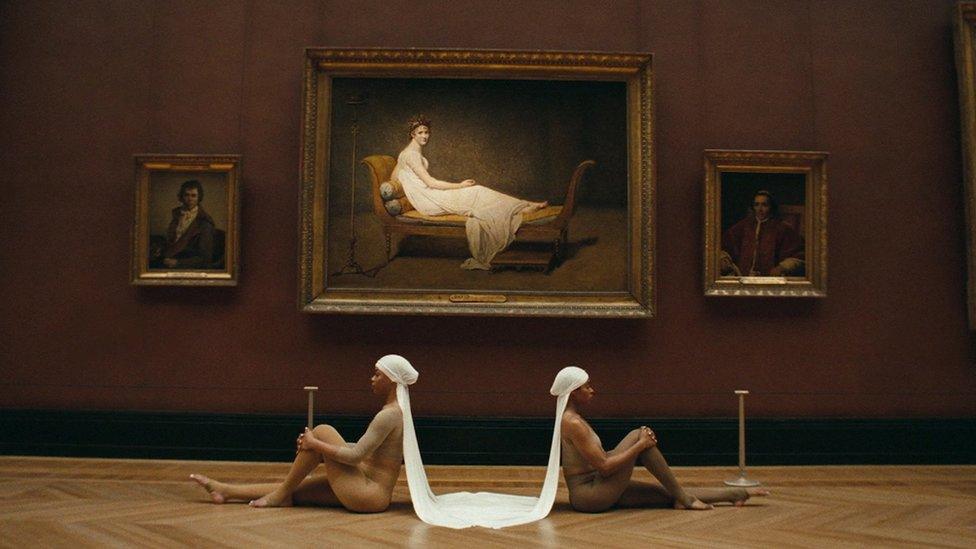
The two women are seen sitting in front of the Portrait of Madame Récamier (1800)
Two black women are sitting on the floor wearing light brown tights and body-hugging beige vests. They are in profile, facing away from each other, and positioned at either side of David's painting of the famous 19th Century French socialite.
Linking the two women together is a flowing piece of white material, each end of which they wear on their heads like a turban.
Above them, Madame Récamier reclines on her antique sofa, dressed in a simple sleeveless white dress, her head turned towards the viewer. The design of the sofa is similar to that of a sleigh-bed, with rising wooden ends.
It is these bed ends that the women on the floor echo, the variance in the darkness of their skin matching the different tones of the wood in the painting.
The cloth that links them represents the dress worn by the painting's subject. The message is clear: It was on the backs of subjugated black people from the French colonies that Madame Récamie was able to enjoy her life of leisure and pleasure.
The Carters' Louvre takeover isn't just about protest; it is about power too.
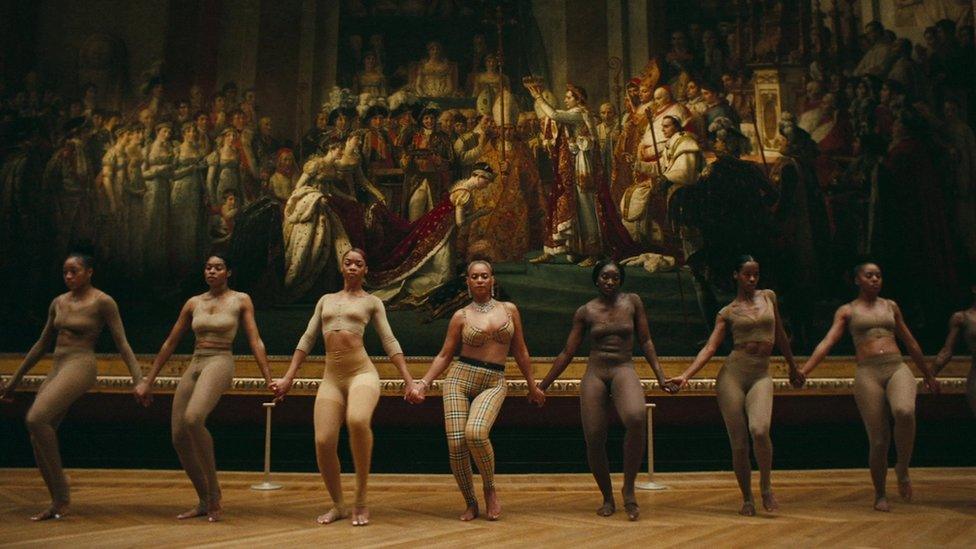
Beyonce dances to the backdrop of The Consecration of the Emperor Napoleon (1806-7)
We meet them in the museum's Salle des Etats gallery, which was originally built for Napoleon III to preside over major legislative sessions in the late 1850s.
Today it houses the Louvre's Venetian Renaissance paintings as well as the picture for which it is thought 80% of visitors come to see, the Mona Lisa. And that's where we find our besuited pop stars: Beyoncé dressed in pink, Jay-Z in mint green.
They look at us with deadpan expressions mimicking the Mona Lisa's, whose portrait hangs between them. We get what they are saying, we are not looking at one iconic face: we're looking at three.
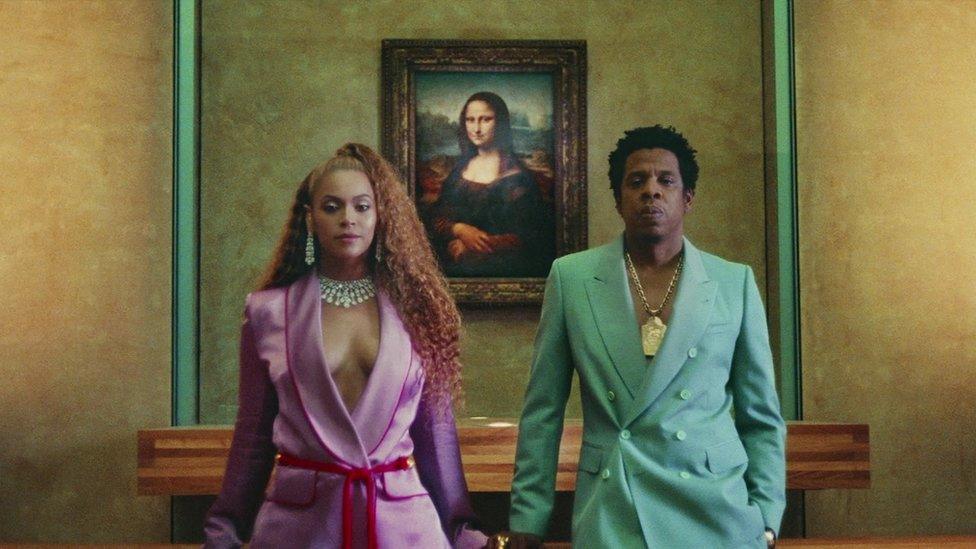
The Carters are not just giving themselves the same status as Da Vinci's masterpiece; they are transforming the world's most famous painting from a single image into a triptych.
The song for which the promo has been made sets the tone. Its profane title, Apeshit, repeated in every chorus: "Have you ever seen a crowd goin' apeshit?"
"I can't believe we made it," they duet as they take ownership of Paris's temple of cultural icons, which until their residency, had barely a black face in it.
"We livin' lavish, lavish," Beyoncé sings draped in white silk. "I got expensive fabrics, I got expensive habits."
These are not words of apology for being overtly materialistic. She's boasting. Here she is, a successful black woman, talking about her opulent tastes while enjoying being the inheritor of Napoleon's. And in his back yard, too.
The video is a smart piece of work, albeit a little rushed at times. Not every shot works, not every idea lands.
But the overall point is powerfully put. The game is up for those institutions - be it Hollywood, Broadway or the Louvre - which have ignored black artists, refused them a voice, or a seat at the top table.
- Published17 June 2018

- Published7 June 2018
